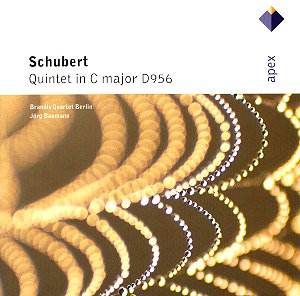Mozart crowned his achievement as a composer of chamber
music with string quintets, and so too did Schubert. But whereas Mozart
used an extra viola in addition to the quartet ensemble of two violins,
viola and cello, Schubert preferred to use an extra cello.
Schubert's Quintet is a masterpiece which transcends
mere imitation. It was composed during the last weeks of his life, probably
with no particular expectation of performance. As with so much of his
music, the impulse to write it was his own creative necessity. The two
cellos rarely play together in order to add richness and weight of tone;
far more important is the preference for allowing one to soar upwards
while the other supplies a deep bass, far beneath the viola's range.
The cellos are also contrasted by the allocation of plucked (pizzicato)
notes and bowed (arco).
The richness of invention is nothing short of miraculous,
throughout the work, and any performance by talented musicians will
inevitably open up new insights. So it proves here, and rather more
than usual, I am inclined to suggest. For the Brandis Quartet and Jörg
Baumann have the measure of Schubert's long-term vision, managing to
generate activity as well as poetry among the generally slow tempi and
extended lines.
One reason for their success is the careful articulation
of dynamic shadings, and the excellent recording balance which makes
the telling pizzicati of either cello make its mark when required. The
technique of these players is second to none, and the music always sounds
well. This is an important consideration in slower music, of course,
and particularly so in this work.
The sonorities in the slow movement are beautifully
sustained, and the subtle shift of emphasis for the contrasted middle
section is highly effective, observing for once the fact that Schubert
does not ask for a change of tempo at this point. Against this the two
final movements are notable for their rhythmic bite, but again in the
context of rich and fulfilling sonorities. This music is not easy to
bring off, and it demands great concentration of its performers, not
to mention its listeners.
The Brandis ensemble must be commended for their eloquence
and skill, though as with other issues in this admirably budget-priced
series, the booklet is poorly designed and unnecessarily difficult to
read.
Terry Barfoot


